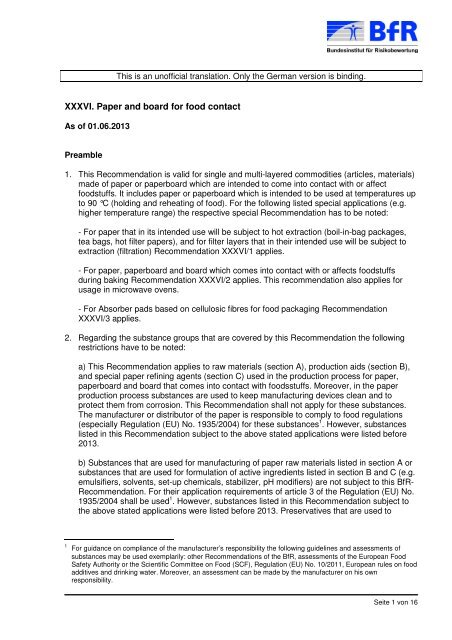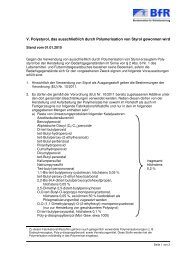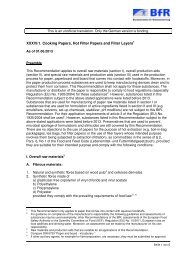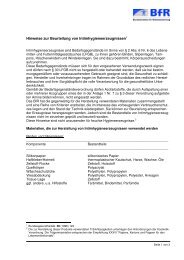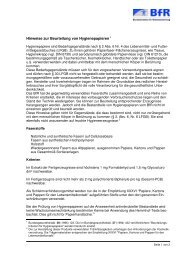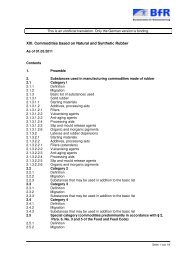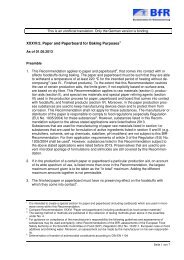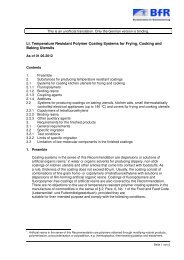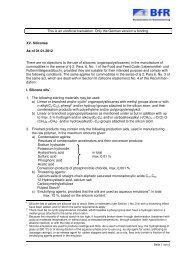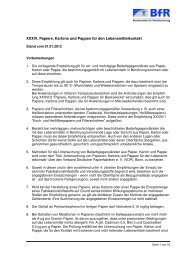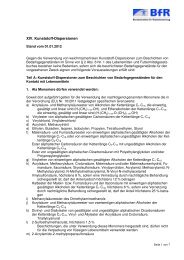XXXVI. Paper and board for food contact
XXXVI. Paper and board for food contact
XXXVI. Paper and board for food contact
You also want an ePaper? Increase the reach of your titles
YUMPU automatically turns print PDFs into web optimized ePapers that Google loves.
This is an unofficial translation. Only the German version is binding.<br />
<strong>XXXVI</strong>. <strong>Paper</strong> <strong>and</strong> <strong>board</strong> <strong>for</strong> <strong>food</strong> <strong>contact</strong><br />
As of 01.06.2013<br />
Preamble<br />
1. This Recommendation is valid <strong>for</strong> single <strong>and</strong> multi-layered commodities (articles, materials)<br />
made of paper or paper<strong>board</strong> which are intended to come into <strong>contact</strong> with or affect<br />
<strong>food</strong>stuffs. It includes paper or paper<strong>board</strong> which is intended to be used at temperatures up<br />
to 90 °C (holding <strong>and</strong> reheating of <strong>food</strong>). For the following listed special applications (e.g.<br />
higher temperature range) the respective special Recommendation has to be noted:<br />
- For paper that in its intended use will be subject to hot extraction (boil-in-bag packages,<br />
tea bags, hot filter papers), <strong>and</strong> <strong>for</strong> filter layers that in their intended use will be subject to<br />
extraction (filtration) Recommendation <strong>XXXVI</strong>/1 applies.<br />
- For paper, paper<strong>board</strong> <strong>and</strong> <strong>board</strong> which comes into <strong>contact</strong> with or affects <strong>food</strong>stuffs<br />
during baking Recommendation <strong>XXXVI</strong>/2 applies. This recommendation also applies <strong>for</strong><br />
usage in microwave ovens.<br />
- For Absorber pads based on cellulosic fibres <strong>for</strong> <strong>food</strong> packaging Recommendation<br />
<strong>XXXVI</strong>/3 applies.<br />
2. Regarding the substance groups that are covered by this Recommendation the following<br />
restrictions have to be noted:<br />
a) This Recommendation applies to raw materials (section A), production aids (section B),<br />
<strong>and</strong> special paper refining agents (section C) used in the production process <strong>for</strong> paper,<br />
paper<strong>board</strong> <strong>and</strong> <strong>board</strong> that comes into <strong>contact</strong> with <strong>food</strong>sstuffs. Moreover, in the paper<br />
production process substances are used to keep manufacturing devices clean <strong>and</strong> to<br />
protect them from corrosion. This Recommendation shall not apply <strong>for</strong> these substances.<br />
The manufacturer or distributor of the paper is responsible to comply to <strong>food</strong> regulations<br />
(especially Regulation (EU) No. 1935/2004) <strong>for</strong> these substances 1 . However, substances<br />
listed in this Recommendation subject to the above stated applications were listed be<strong>for</strong>e<br />
2013.<br />
b) Substances that are used <strong>for</strong> manufacturing of paper raw materials listed in section A or<br />
substances that are used <strong>for</strong> <strong>for</strong>mulation of active ingredients listed in section B <strong>and</strong> C (e.g.<br />
emulsifiers, solvents, set-up chemicals, stabilizer, pH modifiers) are not subject to this BfR-<br />
Recommendation. For their application requirements of article 3 of the Regulation (EU) No.<br />
1935/2004 shall be used 1 . However, substances listed in this Recommendation subject to<br />
the above stated applications were listed be<strong>for</strong>e 2013. Preservatives that are used to<br />
1 For guidance on compliance of the manufacturer’s responsibility the following guidelines <strong>and</strong> assessments of<br />
substances may be used exemplarily: other Recommendations of the BfR, assessments of the European Food<br />
Safety Authority or the Scientific Committee on Food (SCF), Regulation (EU) No. 10/2011, European rules on <strong>food</strong><br />
additives <strong>and</strong> drinking water. Moreover, an assessment can be made by the manufacturer on his own<br />
responsibility.<br />
Seite 1 von 16
Federal Institute <strong>for</strong> Risk Assessment<br />
prevent microbial spoilage of <strong>for</strong>mulations <strong>and</strong> slimicides are still covered by this<br />
Recommendation.<br />
3. Methods <strong>for</strong> testing commodities (materials <strong>and</strong> articles) made of paper or paper<strong>board</strong> are<br />
published under the title "Untersuchung von Papieren, Kartons und Pappen für den<br />
Lebensmittelkontakt" <strong>and</strong> can be obtained from the German Pulp <strong>and</strong> <strong>Paper</strong> Association<br />
(Verb<strong>and</strong> Deutscher Papierfabriken e. V. (VDP), Bonn).<br />
4. The finished paper or paper<strong>board</strong> must have no preserving effect on the <strong>food</strong>stuffs with<br />
which they come into <strong>contact</strong> 2 .<br />
5. To the extent that in this Recommendation the use of certain substances is restricted the<br />
maximum quantities given, if not applied to surface area or otherwise stated, refer to the dry<br />
finished product.<br />
6. If in the production of a certain paper or paper<strong>board</strong> a particular production aid, on account<br />
of its wide spectrum of use, is listed more than once in the Recommendation, the largest<br />
maximum amount given is to be taken as the “in total” maximum. Adding the different<br />
maximum amounts together is not permissible.<br />
7. The finished paper must not contain more than 0.15 mg/kg pentachlorophenol.<br />
8. It is assumed that under normal conditions of use there is no transfer of metal ions to<br />
<strong>food</strong>stuffs when their concentration (determined in cold water extract) does not exceed A µg<br />
per gram paper, whereby “A“ has the following values: cadmium 0.5, lead 3 <strong>and</strong> mercury<br />
0.3 µg per gram paper. Testing is not necessary <strong>for</strong> paper or paper<strong>board</strong> intended <strong>for</strong><br />
<strong>contact</strong> with dry, non-fatty <strong>food</strong>stuffs.<br />
9. Azo dyes after Annex 1, No. 7 (§ 3) of the Commodities Regulation (Bedarfsgegenständeverordnung),<br />
must not be used in the manufacture of <strong>food</strong>-<strong>contact</strong> paper or paper <strong>board</strong> 3 .<br />
10. In a composite, multi-layered or coated material, if the layer which comes into <strong>contact</strong> with<br />
the <strong>food</strong>stuff is made of paper or paper<strong>board</strong> it must comply with this Recommendation.<br />
Also, except <strong>for</strong> traces that are harmless to health <strong>and</strong> have no effect on taste or smell of<br />
the <strong>food</strong>stuff, there must be no migration of substances from other layers into <strong>food</strong>stuffs or<br />
on their surface.<br />
There are no objections to the use of paper or paper<strong>board</strong> in the manufacture of commodities<br />
in the sense of § 2, Para. 6, No. 1 of the Food <strong>and</strong> Feed Code (Lebensmittel- und<br />
Futtermittelgesetzbuch (LFGB)), provided they are suitable <strong>for</strong> their intended purpose <strong>and</strong><br />
comply also with the following conditions:<br />
2 DIN EN 1104: “Determination of the transfer of antimicrobial constituents”<br />
3 Detecting the use of prohibited azo dyes according to "Amtliche Sammlung von Untersuchungsverfahren nach<br />
§ 64 LFGB", method B 82.02-2.<br />
Seite 2 von 16
Federal Institute <strong>for</strong> Risk Assessment<br />
A. Raw materials 4<br />
The following raw materials may be used:<br />
I. Fibrous materials:<br />
1. Natural <strong>and</strong> synthetic cellulose fibres, bleached or unbleached.<br />
2. Fibres of synthetic high polymers, provided they comply with the prevailing requirements of<br />
<strong>food</strong> law.<br />
3. Wood pulp, bleached or unbleached.<br />
4. Recycled fibres made from paper or paper<strong>board</strong> provided that the finished articles comply<br />
with the requirements in the annex of this Recommendation.<br />
II. Fillers:<br />
Natural <strong>and</strong> synthetically produced, insoluble minerals that are harmless to health, such as<br />
carbonates of calcium <strong>and</strong> magnesium, silicon dioxide, silicates, or mixed silicates of sodium,<br />
potassium, magnesium, calcium, aluminium <strong>and</strong> iron, calcium sulfate, calcium sulfoaluminate<br />
(satin white), barium sulfate (free of soluble barium compounds), titanium oxide.<br />
Microspheres 5 made from a copolymer of vinylidene chloride, methyl methacrylate <strong>and</strong><br />
acrylonitrile, filled with isobutane, max. 1.5 %, based on the dry fibres weight.<br />
B. Production aids<br />
The following production aids may be used:<br />
I. Sizing agents:<br />
1. Colophony, addition products of maleic <strong>and</strong> fumaric acid <strong>and</strong>/or of <strong>for</strong>maldehyde with<br />
colophony. No more than 1.0 mg <strong>for</strong>maldehyde/ dm 2 must be detectable in the extract of<br />
the finished product.<br />
2. Casein <strong>and</strong> glue of animal origin<br />
3. Starch 6<br />
3.1 Native 7 starch, physically modified starch, enzymatically modified starch <strong>and</strong><br />
acid-treated starch, as well as the chemically modified starches listed in<br />
Annex 2, List B, Part I of the Regulation on Food Additives (Zusatzstoff-<br />
Verkehrsverordnung)<br />
3.2 Other modified starches<br />
3.2.1 Bleached starch, also treated with sodium, potassium or ammonium peroxy-<br />
4 Since 2013 additives to raw material are not subject <strong>for</strong> this Recommendation (see preamble, section 2). The<br />
following substances were listed be<strong>for</strong>e 2013 <strong>and</strong> are still part of this Recommendation: a) Xylanase (There must<br />
be no detectable residual activity of this enzyme in the finished product.), b) Diethylene triamine pentamethylene<br />
phosphonic acid, max. 0.22 %, based on dry, fibres weight, c) Potassium sulfite, max. 0.01 %.Tetrasodium<br />
iminodisuccinate, max. 0.17 %, based on dry fibres weight, d) Tetrasodium iminodisuccinate, max. 0.17 %, based<br />
on dry fibres weight, e) Activated carbon (The activated carbon must comply with the purity requirements <strong>for</strong> E 153<br />
established by Regulation (EU) No. 231/2012) The application of the substances mentioned above in accordance<br />
with the stated limitations continues to comply with this Recommendation. The application of anthraquinone as<br />
additive to raw material is no longer recommended.<br />
5 The function of the microspheres is to reduce the density of the paper. The initiator, Bis(4-tertbutylcyclohexyl)peroxidicarbonate<br />
may be used, max. 0.45 % based on the micropheres.<br />
6 The general <strong>and</strong> specific purity requirements after Annex 2, List A, Part II of the Regulation on Food Additives<br />
(Zusatzstoff-Verkehrsverordnung) apply.<br />
7 Native <strong>food</strong> starch is a carbohydrate polymer consisting almost entirely of α-D-glucose units. It occurs in granular<br />
<strong>for</strong>m in the organs of certain plants, from which it is extracted.<br />
Seite 3 von 16
Federal Institute <strong>for</strong> Risk Assessment<br />
disulfate, as well as with peroxyacetic acid <strong>and</strong>/or hydrogen peroxide<br />
3.2.2 Oxidatively degraded starch, also treated with hydrogen peroxide, sodium,<br />
potassium or ammonium peroxydisulfate, including dialdehyde starch produced<br />
from oxidised starch with an aldehyde content of at least 90 % 8<br />
3.2.3 Starch esters<br />
3.2.3.1 Monostarch phosphate, also treated with ammonium phosphate or<br />
orthophosphoric acid in the presence of urea<br />
3.2.3.2 Starch acetate, also treated with vinyl acetate (specification of starch:<br />
max. 2.5 % acetyl groups)<br />
3.2.3.3 Starch succinate<br />
3.2.4. Starch ethers<br />
3.2.4.1 Treated with propylene oxide to produce neutral starch ethers (specification<br />
of starch: propylene chlorohydrin, max. 1 mg/kg; degree of substitution (DS),<br />
max. 0.2).<br />
3.2.4.2 Treated with monochloroacetate to produce anionic starch ethers (specification<br />
of starch: sodium glycolate, max. 0.4 %; degree of substitution, max. 0.08).<br />
3.2.4.3 Treated with 3-chloro-2-hydroxypropyl trimethyl ammonium chloride or glycidyl<br />
trimethyl ammonium chloride (specification of starch: epichlorohydrin, max.<br />
1 mg/kg; nitrogen, max. 4.0 %).<br />
3.2.4.4 Treated with 3-chloro-2-hydroxypropyl trimethyl ammonium chloride <strong>and</strong> succinic<br />
anhydride (specification of starch: epichlorohydrin, max. 1 mg/kg; nitrogen,<br />
max. 1.6 %).<br />
3.2.5 Starch, crosslinked with epichlorohydrine <strong>and</strong> treated with 3-chloro-2hydroxypropyl<br />
trimethyl ammonium chloride (specification of starch:<br />
epichlorohydrin, max. 1mg/kg; nitrogen, max. 0.5 %).<br />
3.2.6 Monostarch phosphate, treated with 3-chloro-2-hydroxypropyl trimethyl<br />
ammonium chloride (specification of starch: epichlorohydrin, max. 1 mg/kg;<br />
nitrogen, max. 0.5 %).<br />
4. Cellulose ether<br />
5. Sodium salt of carboxymethyl cellulose, technically pure 9<br />
6. Alginates 6 , xanthane 6 , mannogalactanes 6<br />
7. Galactomannane ethers<br />
7.1 Carboxymethylgalactomannane, residual content in sodium glycolate<br />
max. 0.5 %<br />
7.2 Galactomannane, treated with 3-chloro-2-hydroxypropyl-trimethylammonium<br />
chloride or glycidyl-trimethylammonium chloride (specification: epichlorohydrine<br />
max.1 mg/kg, nitrogen max. 4.0 %)<br />
8. Water-glass <strong>and</strong> alumina gel<br />
9. Dispersions of wax <strong>and</strong> paraffin, provided the waxes <strong>and</strong> paraffins comply with amended<br />
Recommendation XXV, Part I 10 , in total max. 2.0 %.<br />
10. Plastics dispersions, provided they comply with amended Recommendation XIV. In<br />
addition, may also be used as a monomer:<br />
2-(Dimethylamino)ethyl acrylate with a residual content of max. 0.01 mg/dm 2<br />
N-[3-(dimethylamino) propyl] methacrylic amide<br />
2-(N,N,N-trimethyl ammonium)ethylmethacrylat chloride<br />
11. Reemulsifiable polyvinyl chloride, provided it complies with amended Recommendation II 11 .<br />
12. Di-alkyl(C10-C22)diketenes, which can contain up to 65 % isoalkyl groups, max. 1.0 %<br />
8<br />
See method <strong>for</strong> analysing tobacco additives, "Bestimmung der Dialdehydeinheiten in Oxi- bzw. Dialdehydstärke",<br />
Bundesgesundheitsblatt 8 (1965) 110.<br />
9<br />
The Sodium glycolate content may not exceed 12 %.<br />
10<br />
Recommendation XXV. " Hard paraffins, microcrystalline waxes <strong>and</strong> mixtures of these with waxes, resins <strong>and</strong><br />
plastics "<br />
11<br />
Recommendation II. "Plasticizer-free polyvinyl chloride ..."<br />
Seite 4 von 16
Federal Institute <strong>for</strong> Risk Assessment<br />
13. Condensation products of melamine, <strong>for</strong>maldehyde <strong>and</strong> ω-aminocaproic acid, max. 1.0 %.<br />
No more than 1.0 mg <strong>for</strong>maldehyde/dm 2 must be detectable in the extract of the finished<br />
product.<br />
14. Sodium <strong>and</strong> ammonium salts of copolymers of isopropyl maleate half ester<br />
(approx. 25 %), acrylic acid (approx. 16 %) <strong>and</strong> styrene (approx. 59 %), in total max. 0.5 %,<br />
based on weight of the dry paper.<br />
15. A mixture consisting of the ammonium salt of a copolymer of styrene <strong>and</strong> maleic acid<br />
anhydride (50 : 50) with a copolymer of acrylic acid n-butyl ester <strong>and</strong> acrylonitrile (70 : 30)<br />
in the ratio of 1 : 2, max. 0.6 %, based on weight of the dry paper.<br />
16. Ammonium salt of a copolymer of maleic acid anhydride, isopropyl maleate half ester <strong>and</strong><br />
diisobutylene, max. 0.5 %, based on weight of the dry paper.<br />
17. Ammonium salt of a copolymer of styrene (approx. 60 %), acrylic acid (approx. 23 %) <strong>and</strong><br />
maleic acid (approx. 17 %), max. 0.5 %, based on weight of the dry paper.<br />
18. Di-sodium salt of a copolymer of styrene (approx. 50 %) <strong>and</strong> maleic acid (approx. 50 %),<br />
max. 0.7 %, based on weight of the dry paper.<br />
19. Cationic, water-soluble polyurethane, cross-linked with epichlorohydrin 12 , made from<br />
glycerol monostearate, toluylene diisocyanate <strong>and</strong> N-methyl diethanol amine (mean<br />
mol. wt. 100 000), max. 0.6 %, based on the dry fibres weight<br />
or<br />
Cationic, water-soluble polyurethanes, made from glycerol monostearate, toluylene<br />
diisocyanate <strong>and</strong> N-methyl diethanol amine (mean mol. wt. 10 000), max. 0.15 %, based on<br />
the fibres weight<br />
or<br />
Anionic, water-soluble polyurethanes, made from glycerol monostearate, toluylene<br />
diisocyanate, dimethylol propionic acid <strong>and</strong> N-methyl diethanol amine (mean mol. wt. 10<br />
000), max. 0.15 %, based on the dry fibres weight.<br />
In producing the a<strong>for</strong>ementioned polyurethanes, in each case a maximum of 0.03 % dibutyl<br />
tin diacetate, based on the sizing agent, may be used; 1 dm 2 of sized paper must not<br />
contain more than 0.3 µg dibutyl tin diacetate. Primary aromatic amines must not be<br />
detectable in extract of the finished product. 13<br />
As preservative <strong>for</strong> the a<strong>for</strong>ementioned polyurethanes, max. 0.5 % <strong>for</strong>maldehyde, based on<br />
the sizing agent, may be used.<br />
20. Copolymer of maleic acid <strong>and</strong> dicyclopentadiene (ammonium salt), max. 2.0 mg/dm 2 .<br />
21. 3-Alkenyl(C15-C21)-dihydrofuran-2,5-dione, max. 1.0 %.<br />
22. Cereal flour<br />
1. treated with acids<br />
2. treated with monochloroacetic acid to produce anionic cereal flour ethers (specification:<br />
sodium glycolate, max. 0.4 %; degree of substitution, max. 0.08)<br />
3. treated with glycidyl trimethyl ammonium chloride (specification: epichlorohydrin,<br />
max. 1 mg/kg).<br />
23. Copolymer of acrylamide <strong>and</strong> acrylic acid, cross-linked with N,N’-methylenebis(acrylamide),<br />
max. 1.0 %<br />
24. Copolymer of acrylamide, 2-[(methacryloyloxy)ethyl]trimethyl ammonium chloride,<br />
N,N'-methylene-bis(acrylamide) <strong>and</strong> itaconic acid, max. 1.0 %, based on the dry fibres<br />
weight.<br />
12 No ethyleneimine must be detectable in the resin (detection limit 0.1 mg/kg). 1,3-Dichloro-2-propanol must not be<br />
detectable in water extract of the finished product (detection limit 2 µg/l). The transfer of 3-monochloro-1,2propanediol<br />
into the water extract of the finished products must be as low as technically achievable, a limit of<br />
12 µg/l must not be exceeded in any case. For compliance with the requirement in respect to chloropropanols,<br />
a transitional period has been granted until the 31.03.2002.<br />
13 On the determination of primary aromatic amines in aqueous extracts see: Amtliche Sammlung von Untersuchungsverfahren<br />
nach § 64 LFGB, Method L. No. 00.00-6, "Untersuchung von Lebensmitteln - Bestimmung von<br />
primären aromatischen Aminen in wäßrigen Prüflebensmitteln".<br />
Seite 5 von 16
Federal Institute <strong>for</strong> Risk Assessment<br />
25. Copolymer of acrylamide, 2-[(methacryloyloxy)ethyl]trimethyl ammonium chloride,<br />
N,N'-methylene-bis(acrylamide), itaconic acid <strong>and</strong> glyoxal, max. 1.0 %, based on the<br />
dry fibres weight.<br />
26. Addition product of fumaric acid with colophony, cross-linked with triethanol amine,<br />
max. 4.0 %, based on the dry fibres weight.<br />
27. Hydroxyethyl starch<br />
28. Anhydrides of natural fatty acids, max. 0.2 %, based on the dry fibres weight<br />
29. Galactomannane phosphoric acid ester, max. 0.25 %, based on the dry fibres weight<br />
As emulsifier <strong>for</strong> the sizing agents, max. 0.02 % sodium-2-stearoyllactylate may be used.<br />
II. Precipitating, fixing <strong>and</strong> parchmentisation agents:<br />
1. Aluminium salts such as aluminium sulfate, aluminium chloride hydroxide, aluminium<br />
<strong>for</strong>mate <strong>and</strong> sodium aluminate.<br />
2. Sulfuric acid<br />
3. Ammonia<br />
4. Sodium carbonate, sodium hydrogen carbonate, sodium phosphate<br />
5. Tannin<br />
6. Condensation products of urea, dicy<strong>and</strong>iamide, melamine with <strong>for</strong>maldehyde. Extract<br />
of the finished products must contain no more than 1.0 mg <strong>for</strong>maldehyde per dm 2<br />
(compare C I 2 <strong>and</strong> 3)<br />
7. Condensation products of aromatic sulfonic acids with <strong>for</strong>maldehyde, max. 1.0 %.<br />
Extract of the finished products must contain no more than 1.0 mg <strong>for</strong>maldehyde per dm 2<br />
(compare B V 8)<br />
8. Sodium salts of ethylenediamine tetraacetic acid <strong>and</strong> diethylenetriamine pentaacetic acid<br />
<strong>and</strong> N-(2-hydroxyethyl)ethylenediamine-triacetic acid<br />
9. Gluconic acid<br />
10. Vinyl<strong>for</strong>mamide-vinylamine copolymer, max. 0.4 %<br />
11. Polycondensate of dicy<strong>and</strong>iamide <strong>and</strong> diethylenetriamine, max. 0.45 %<br />
12. Polyethyleneimine, modified with polyethyleneglycol <strong>and</strong> epichlorohydrin, max. 0.2 %<br />
13. Choline <strong>and</strong> its salts<br />
14. Copolymer of vinyl<strong>for</strong>mamide, vinylamine <strong>and</strong> acrylic acid, max. 1 %, based on the dry<br />
fibres weight<br />
III. Retention agents:<br />
1. Homopolymers <strong>and</strong> copolymers of<br />
a) Acrylamide<br />
b) Acrylic acid<br />
c) 3-(N,N,N-Trimethylammonium)propylacrylamide, chloride<br />
d) 2-(N,N,N-Trimethyl ammonium)ethylacrylate, chloride<br />
e) 2-(N,N,N-Trimethyl ammonium)ethylmethacrylate, chloride<br />
f) 2-(N,N-Dimethyl-N-benzylammonium)ethylacrylate, chloride<br />
max. 0.1 %, provided that the polymers contain no more than 0.1 % monomeric acrylamide<br />
<strong>and</strong> 0.5 % of the monomers listed under b) - f) 14 .<br />
2. Polyethyleneimine, max. 0.5 % 15 (compare B. IV. 1 <strong>and</strong> B. V. 11).<br />
14 Hydrocarbon solvents (paraffinic, naphthenic, with a chain length from C10 to C20) can be used as <strong>for</strong>mulating<br />
agents. These solvents must comply with the "Purity requirements <strong>for</strong> liquid paraffins" in the 155th Communication<br />
of Bundesgesundheitsblatt 25 (1982) 192. The transfer of these parts of solvents with a chain length from C10 to<br />
C16 from the final product (in)to the <strong>food</strong>stuff may not exceed 12 mg/kg <strong>food</strong>stuff (preliminary limit). For parts of<br />
solvents with a chain length from C16 to C20 from the final product (in)to the <strong>food</strong>stuff may not exceed 12 mg/kg<br />
<strong>food</strong>stuff (preliminary limit).<br />
Seite 6 von 16
Federal Institute <strong>for</strong> Risk Assessment<br />
3. Cross-linked, cationic polyalkylene amines 13 (compare C. I. 4) i.e.:<br />
in total max. 4.0 %:<br />
a) Polyamine-epichlorohydrin resin, produced from epichlorohydrin <strong>and</strong><br />
diaminopropylmethylamine 12<br />
b) Polyamide-epichlorohydrin resin, produced from epichlorohydrin, adipic acid, caprolactam,<br />
diethylenetriamine <strong>and</strong>/or ethylenediamine 12<br />
c) Polyamide-epichlorohydrin resin, produced from adipic acid, diethylenetriamine <strong>and</strong><br />
epichlorohydrin or a mixture of epichlorohydrin with ammonia 12<br />
d) Polyamide-polyamine-epichlorohydrin resin, produced from epichlorohydrin, adipic acid<br />
dimethyl ester <strong>and</strong> diethylenetriamine 12<br />
e) Polyamide-polyamine-dichloroethane resin, produced from dichloroethane <strong>and</strong> an<br />
amide of adipic acid, caprolactam <strong>and</strong> diethylenetriamine<br />
f) Polyamide-epichlorohydrin resin, produced from epichlorohydrin, diethylenetriamine,<br />
adipic acid <strong>and</strong> ethyleneimine 12 , max. 0.5 %<br />
g) Polyamide-epichlorohydrin resin, produced from adipic acid, diethylenetriamine <strong>and</strong> a<br />
mixture of epichlorohydrin <strong>and</strong> dimethylamine 12 , max. 0.2 %<br />
h) Polyamide-epichlorohydrin resin, produced from polyepichlorohydrin, diethylenetriamine<br />
<strong>and</strong> a mixture of epichlorohydrin <strong>and</strong> dimethylamine 12 , max. 0.2 %<br />
i) Polyamide-epichlorohydrin resin, produced from epichlorohydrin, diethylenetriamine,<br />
adipic acid, ethyleneimine <strong>and</strong> polyethyleneglycol 12 , max. 0.2 %<br />
j) Polyamide-polyamine-epichlorohydrin resin, produced from epichlorohydrin, adipic acid<br />
dimethyl ester, glutaric acid dimethyl ester <strong>and</strong> diethylenetriamine 12 , max. 2.0 %<br />
k) Polyamide-polyamine-dichloroethane resin, produced from adipic acid, diethylenetriamine<br />
<strong>and</strong> 1,2-dichloroethane, max. 0.2 %<br />
l) Polyamide-polyamine-dichloroethane resin, produced from adipic acid, diethylenetriamine,<br />
<strong>and</strong> a mixture of ethylenediamine, diethylenetriamine, triethylenetetramine,<br />
tetraethylenepentamine, pentaethylenehexamine, aminomethylpiperazine <strong>and</strong> 1,2dichloroethane,<br />
max. 0.2 %<br />
m) Polyamine-dichloroethane resin, produced from bis-(3-aminopropyl)-methylamine <strong>and</strong><br />
1,2-dichloroethane, max. 0.2 %<br />
n) Polyamideamine-polyetheramine-epichlorohydrin resin, produced from diethylenetri-<br />
amine, caprolactam, adipic acid, polyethyleneglycol <strong>and</strong> epichlorohydrin 12 , max. 0.2 %<br />
o) Polyamidoamine-ethyleneimine resin, produced from adipic acid, a mixture of<br />
ethylenediamine <strong>and</strong> N-(2-aminoethyl)-1,3-propylenediamine, N,N’-[bis-(3aminopropyl)]-1,2-ethylenediamine,<br />
ethyleneimine, epichlorohydrin <strong>and</strong><br />
polyethyleneglycol 12 , max. 0.2 %<br />
4. High-molecular, cationic polyamide amine, produced from triethylenetetramine <strong>and</strong> adipic<br />
acid with a content of 15 % diethyleneglycol monomethyl ether (as diluting agent) or a<br />
mixture of 70 parts of this polyamide amine solution with 30 parts of sulfatised sperm oil, in<br />
each case no more than 0.2 % (calculated as polyamide amine in dry the fibre).<br />
5. a) Mixture of<br />
Polyamide-epichlorohydrin resin, produced from adipic acid, diethylenetriamine <strong>and</strong><br />
a mixture of epichlorohydrin <strong>and</strong> dimethylamine 12 , max. 0.05 %,<br />
linear, high-molecular polyethylene oxide, max. 0.015 % <strong>and</strong><br />
a condensation product of xylene sulfonic acid, dihydroxydiphenylsulfone <strong>and</strong> <strong>for</strong>m<br />
aldehyde (sodium <strong>and</strong> ammonium salt), max. 0.1 %<br />
b) Mixture of<br />
Polyamide-epichlorohydrin resin, produced from adipic acid, diethylenetriamine <strong>and</strong><br />
15 This production aid becomes firmly attached to the cellulose fibre. However, if under certain conditions of use,<br />
significant amounts of it, or its conversion products, may migrate out of the paper, appropriate testing instructions<br />
will be published at a future date.<br />
Seite 7 von 16
Federal Institute <strong>for</strong> Risk Assessment<br />
a mixture of epichlorohydrin <strong>and</strong> dimethylamine 12 , max. 0.05 %,<br />
linear, high-molecular polyethylene oxide, max. 0.015 % <strong>and</strong><br />
a condensation product of β-naphtholsulfonic acid, phenol <strong>and</strong> <strong>for</strong>maldehyde as sodium<br />
salt, max. 0.06 %<br />
The limits given above under a) <strong>and</strong> b) <strong>for</strong> individual components are based on dry fibres<br />
weight of the particular paper.<br />
6. Reaction product of polyacrylamide with <strong>for</strong>maldehyde <strong>and</strong> dimethylamine 16 , max. 0.06 %,<br />
based on weight of the dry paper. Extract of the finished products must not contain more<br />
than 1.0 mg <strong>for</strong>maldehyde per dm 2 .<br />
7. Copolymer of dimethylamine <strong>and</strong> epichlorohydrin 12 , max. 0.25 %<br />
8. Copolymer of dimethylamine ethylenediamine <strong>and</strong> epichlorohydrin 12 , max. 3 %<br />
9. Homopolymers <strong>and</strong> copolymers of vinyl<strong>for</strong>mamide <strong>and</strong> vinylamine, max. 0.2 %<br />
10. Copolymer of acrylamide <strong>and</strong> diallyldimethyl ammonium chloride, max. 0.02 %, based on<br />
the dry fibres weight.<br />
11. Polydimethyldiallyl ammonium chloride, max. 0.15 %<br />
12. Vinylamine-diallyldimethylammoniumchlorid-copolymer, made by Hofmann degradation of<br />
the amide groups of a acrylamid-diallyldimethylammoniumchloride copolymer, max. 0.5 %<br />
based on the dry fibres weight<br />
13. Copolymer of acrylamid <strong>and</strong> 2-(N,N,N-trimethyl ammonium)ethylacrylate, chloride, max.<br />
1 %, provided that the polymers contain no more than 0.1 % monomeric acrylamide <strong>and</strong><br />
0.05 % of 2-(N,N,N-trimethyl ammonium)ethylacrylate, chloride.<br />
IV. Dewatering accelerators:<br />
1. Polyethyleneimine, max. 0.5 % 15 (compare B. III. 2 <strong>and</strong> B. V. 11).<br />
2. Alkylaryl sulfonates, max. 1.0 % 17 .<br />
3. Silicone-containing paraffin dispersions, provided that the silicones <strong>and</strong> paraffins comply<br />
with amended Recommendations XV 18 <strong>and</strong> XXV, Part I 10 , max. 0.5 % (based on dispersion<br />
dry substance)<br />
4. Lignosulfonic acid, as well as its calcium, magnesium, sodium <strong>and</strong> ammonium salts, in total,<br />
max. 1.0 %<br />
5. Cellulase 19<br />
6. Water-glass, stabilised with 0.42 % sodium tetraborate, based on the <strong>for</strong>mulation.<br />
V. Dispersion <strong>and</strong> flotation agents:<br />
1. Polyvinylpyrrolidone (mol. wt. min. 11 000)<br />
2. Alkyl (C10-C20) sulfonates<br />
3. Alkylaryl sulfonates (compare B. IV. 2)<br />
4. Alkali salts of mainly linear-condensed polyphosphates. The content of cyclic-condensed<br />
metaphosphates must not exceed 8.0 %<br />
5. Alkyl polyglycol ether with 6 - 12 ethylene oxide groups<br />
6. Alkylphenol polyglycol ether with 6 - 12 ethylene oxide groups 20<br />
7. Sulfonated castor oil<br />
8. Condensation products of aromatic sulfonic acids with <strong>for</strong>maldehyde. Extract of the finished<br />
products must contain no more than 1.0 mg <strong>for</strong>maldehyde per dm 2 (compare B. II. 7)<br />
16 Dimethylamine must not be detectable in the aqueous extract (detection limit: 0.002 mg/dm 2 ). Residual<br />
monomeric acrylamide, based on the reaction product of polyacrylamide with <strong>for</strong>maldehyde <strong>and</strong> dimethylamine,<br />
must not exceed 0.1 %.<br />
17 This production aid is washed out to the paper during manufacture.<br />
18 Recommendation XV. "Silicones"<br />
19 There must be no detectable residual activity of this enzyme in the finished product.<br />
20 The restrictions of Regulation (EU) No 1907/2006 concerning Nonylphenol ethoxylate have to be obeyed.<br />
Seite 8 von 16
Federal Institute <strong>for</strong> Risk Assessment<br />
9. Lignosulfonic acid, as well as its calcium, magnesium, sodium <strong>and</strong> ammonium salts<br />
10. Sodium lauryl sulfate<br />
Of the production aids listed under 1. to 10. up to 1 % of each may be used, but in total no<br />
more than 3.0 %.<br />
11. Polyethyleneimine, max. 0.5 % 15 (compare B. III. 2 <strong>and</strong> B. IV. 1)<br />
12. Sodium, polyacrylic acid, max. 0.5 %<br />
13. Alkyl(C13)polyglycol ether with 5 - 7 ethylene oxide groups <strong>and</strong> 1 - 2 terminal propylene<br />
oxide groups, max. 0.014 %<br />
14. Citric acid<br />
15. 1,2-Dihydroxy-C12-C14-alkyloxethylates, max. 1.0 %, based on the dry fibres weight<br />
16. 2-Amino-2-methyl-1-propanol; no more than 0.25 mg/dm² must be detectable in extract of<br />
the finished product.<br />
17. 2-Phosphonobutane-1,2,4-tricarboxylic acid, max. 0.01 %, based on the dry fibres weight.<br />
18. Polyaspartic acid, max. 0.5 %<br />
19. Reaction product of 2-ethylhexylglycidyl ether with polyethylene glycol, max. 0.71 mg/dm 2<br />
The reaction product has to comply with the following specification:<br />
Number average molecular weight (Mn) ≥ 9 000 daltons +/- 1 500 daltons<br />
Weight average molecular weight (Mw) ≥ 10 000 daltons +/- 1 500 daltons<br />
Polydispersity index (Mw/Mn) = 1.0 - 1.3<br />
2-ethylhexylglycidyl ether must not be detectable in the final product (limit of detection:<br />
< 0.02 µg/dm 2 paper).<br />
20. Polyethyleneglycol ester of castor oil, max. 5 mg/dm 2<br />
VI. Defoamers:<br />
1. Organopolysiloxanes with methyl <strong>and</strong>/or phenyl groups (silicone oil) according to Section I of<br />
Recommendation XV 18 . Kinematic viscosity of the silicone oils, determined according to<br />
DIN 51 562 at 20 °C, min. 100 mm 2 s -1 .<br />
2. Triisobutylphosphate<br />
3. Linear primary alkan-1-oles/alken-1-oles with 8-26 carbon-units(fatty alcohols), also in<br />
emulsified <strong>for</strong>m 21<br />
4. Fatty acid esters of mono <strong>and</strong> polyhydric aliphatic alcohols (C1-C22)<br />
5. Fatty acid esters with polyethyleneglycol <strong>and</strong> polypropyleneglycol<br />
6. Alkylsulfonamides (C10-C20)<br />
7. Liquid paraffins, max. 0.1 % (<strong>for</strong> purity requirements see 155th Communication).<br />
8. Gelatine<br />
Of each of the production aids listed under 1. to 8. no more than 0.1 % may be used.<br />
9. Copolymer of glycerol with ethylene oxide <strong>and</strong> propylene oxide, esterified with coconut fatty<br />
acid or oleic acid, of each max. 0.075 %<br />
10. N,N’-Ethylene-bis-stearamide<br />
11. Sorbitan monostearate, polyoxyethylene sorbitan monostearate, polyoxyethylene sorbitan<br />
monooleate with 20 ethylene oxide end groups, each max. 0.01 %<br />
12. Sorbitan monooleate, max. 0.1 %<br />
13. Edible oil<br />
14. Sodium di-(2-ethylhexyl) sulfosuccinate, max. 0.001 %, based on the dry fibres weight<br />
15. Poly-(ω-hydroxy-(polyoxyethylene-polyoxypropylene-propyl)methylsiloxane)-copolydimethylsiloxane<br />
reaction product with hexamethylenediisocyanate, max. 0.0004 % based<br />
on dry fibres weight<br />
16. Polypropylene glycol, max. 1 mg/dm 2<br />
21 Max. 2 % liquid paraffin, sodium monoalkyl-dialkylphenoxybenzene-disulfonate, max. 2 %, <strong>and</strong> a total of max. 2 %<br />
alkyl <strong>and</strong> alkyaryloxethylates <strong>and</strong> their esters with sulfuric acid (as emulsifiers) may be added to 20 - 25 %<br />
aqueous solutions of this antifoam agent. The liquid paraffins must comply with the "Purity requirements <strong>for</strong> liquid<br />
paraffins" in the 155th Communication of Bundesgesundheitsblatt 25 (1982) 192.<br />
Seite 9 von 16
Federal Institute <strong>for</strong> Risk Assessment<br />
17. Poly(ethylene propylene) glycol, max. 1 mg/dm 2<br />
18. a) 2,4,7,9-tetramethyl-5-decyne-4,7-diol<br />
b) 3,6-dimethyl-4-octiyne-3,6-diol<br />
c) 2,5,8,11-tetramethyl-6-dodecyne-5,8-diol<br />
The transfer of these three substances from the final product (in)to <strong>food</strong>stuff may not<br />
exceed 0.05 mg/kg <strong>food</strong>stuff (sum of the three substances).<br />
VII. Slimicides:<br />
a) Enzymatic agents<br />
1. Fructose polysaccharide (levan)-hydrolase, 12.5 mg dry substance per kg paper. No<br />
more than one unit of levanase activity must be detectable.<br />
b) Antimicrobial agents<br />
1. Sodium chlorite, hydrogen peroxide, sodium peroxide, sodium hydrogen sulfite, as well<br />
as peroxyacetic acid, max. 0.1 %, based on dry fibres weight.<br />
2. 1,4-Bis(bromoacetoxy)butene. Extract of the finished products must contain no more than<br />
0.01 mg bromine per dm 2 .<br />
3. Tetramethyl thiuram disulfide. This substance must not be detectable in extract of the<br />
finished products.<br />
4. 3,5-Dimethyl-tetrahydro-1,3,5-thiadiazine-2-thione. This substance must not be<br />
detectable in extract of the finished products.<br />
5. Bromohydroxyacetophenone. This substance must not be detectable in extract of the<br />
finished products.<br />
6. Di-sodium-cyano-dithioimidocarbonate <strong>and</strong>/or potassium-N-methyl-dithiocarbamate.<br />
Neither substance must not be detectable in extract of the finished products.<br />
7. N-(2-p-chlorobenzoylethyl)-hexaminium chloride. Extract of the finished products must<br />
contain no more than 1.0 mg <strong>for</strong>maldehyde per dm 2 . The breakdown product, 2-(pchlorobenzoyl)-ethylamine<br />
must not be detectable in methanol extract.<br />
8. Methylene-bis-thiocyanate. This substance must not be detectable in extract of the<br />
finished products.<br />
9. Potassium-N-hydroxymethyl-N'-methyl-dithiocarbamate <strong>and</strong> Sodium-2-Mercaptobenzothiazole.<br />
Neither substance, nor their conversion products (mainly methylthiourea,<br />
N,N'-dimethylthiourea <strong>and</strong> dithiocarbamates) must be detectable in extract of the<br />
finished product.<br />
10. 2-Oxo-2(4-hydroxy-phenyl)-acethydroxamic acid chloride. This substance must not be<br />
detectable in extract of the finished product.<br />
11. 2-Bromo-2-nitropropane-1,3-diol, max. 0.003 %, based on dry fibres weight. This<br />
substance must not be detectable in extract of the finished product.<br />
12. 2,2-Dibromo-3-nitrilopropionamide, max. 0.0045 %, based on dry fibres weight. This<br />
substance must not be detectable in the extract of the finished products.<br />
13. Mixture of<br />
Phenyl-(2-chloro-2-cyan-vinyl)sulfone (approx. 80 %), phenyl-(1,2-dichloro-2-cyanvinyl)sulfone<br />
(approx. 10 %) <strong>and</strong> 2-phenyl-sulfonylpropionitrile (approx. 10 %), in total,<br />
max. 0.001 %, based on dry fibres weight.<br />
These substances <strong>and</strong> the degradation product, phenylsulfonyl acetonitrile, must not be<br />
detectable in the extract of the finished product.<br />
14. 1,2-Dibromo-2,4-dicyanobutane, max. 0.005 %, based on dry fibres weight. This<br />
substance must not be detectable in extract of the finished product (detection limit of<br />
method of analysis: 0.6 µg/dm 2 ).<br />
15. 4,5-Dichloro-(3 H)-1,2-dithiol-3-one, max. 0.004 %, based on dry fibres weight. Extract<br />
of finished products must not contain more than 2.0 mg of this substance per kg dry<br />
fibres.<br />
Seite 10 von 16
Federal Institute <strong>for</strong> Risk Assessment<br />
16. β-Bromo-β-nitrostyrene, max. 0.045 %, based on dry fibres weight 22 . This substance<br />
must not be detectable in the extract of the finished product (detection limit: 0.06 mg/kg<br />
paper).<br />
17. Glutaraldehyde, max. 2.5 %, based on dry fibres weight. No more than 2 mg<br />
glutaraldehyde must be detectable in 1 kg of finished product.<br />
18. 1-Bromo-3-chloro-5,5-dimethylhydantoin, max. 0.04 %, based on dry fibres weight. No<br />
hypochlorite <strong>and</strong> hypobromite must be detectable in the extract of the finished product.<br />
19. Didecyl dimethyl ammonium chloride, max. 0.05 %, based on the dry fibres weight.<br />
20. 2-(Thiocyanatomethylthio)-benzothiazole, max. 0.00045 %, based on dry fibres weight.<br />
21. Tetrakis(hydroxymethyl)phosponium sulfate.<br />
The extract of the finished products must contain no more than 0.15 ppm of this<br />
substance.<br />
22. Mixture of 1,3-dichloro-5-ethyl-5-methylhydantoin, 1,3-dichloro-5,5-dimethylhydantoin<br />
<strong>and</strong> 1-bromo-3-chloro-5,5-dimethylhydantoin in the ratio of 1 : 3 : 6, max. 0.04 %, based<br />
on the dry fibres weigth. No hypochlorite or hypobromite must be detectable in the<br />
extract of the finished product.<br />
23. Mixture of 1,3-dichloro-5-ethyl-5-methylhydantoin <strong>and</strong> 1,3-dichloro-5,5dimethylhydantoin<br />
in the ratio of 1 : 5, max. 0.04 %, based on the dry fibres weight.<br />
24. Ammonium bromide/sodium hypochlorite adduct, max. 0.02 % (active substance<br />
determined as chlorine), based on the dry fibres weight<br />
25. Dodecylguanidine hydrochloride, max. 0.02 %, based on the dry fibres weight.<br />
26. Alkali-stabilised solution of hypobromite, max. 0.07 %, based on the dry fibres weight.<br />
The sodium hypobromite content of the solution is max. 10 % <strong>and</strong> the sodium sulfamate<br />
content is max. 12 %.<br />
27. 1,3-Dimethylol-5,5-dimethylhydantoine, max. 0,04 %, based on the dry fibres weight.<br />
28. Chlorine dioxide.<br />
29. Tetrahydro-1,3,4,6-tetrakis-(hydroxymethyl)-imidazo(4,5-d)imidazole-2,5(1H,3H)-dione<br />
as <strong>for</strong>maldehyde donator system with an average ratio of <strong>for</strong>maldehyde: acetylene<br />
diurea of 3.1 : 1 to 3.5 : 1. In the extract of the finished products not more than 0.3<br />
mg/dm², corresponding to 0.1 mg <strong>for</strong>maldehyde/dm², must be detectable 23 .<br />
30. Sodium hypochlorite, max. 0.028 %, based on the dry fibres weight 24 .<br />
31. Mixture of 5-chloro-2-methyl-4-isothiazolin-3-one (approx. 3 parts) <strong>and</strong> 2-methyl-4isothiazolin-3-one<br />
(approx. 1 part) 25 . No more than 0.5 µg/dm 2 of the mentioned<br />
isothiazolinones in total must be detectable in the extract of the finished product.<br />
32. 1,2-Benzisothiazolin-3-one 25 . No more than 10 µg/dm 2 of this substance must be<br />
detectable in the extract of the finished product.<br />
33. 4,5-Dichloro-2-n-octyl-2H-isothiazol-3-one. No more than 5 µg/dm 2 of this substance<br />
must be detectable in the extract of the finished product.<br />
34. 2-methyl-4-isothiazolin-3-one 25 . No more than 1 µg/dm 2 of this substance must be<br />
detectable in the extract of the finished product.<br />
22<br />
Experiments have shown that following cold extraction with n-heptane, the conversion products, benzaldehyde<br />
<strong>and</strong> bromonitromethane are not detectable in the finished product (detection limits <strong>for</strong> benzaldehyde <strong>and</strong><br />
bromonitromethane = 0.04 <strong>and</strong> 2.0 mg/kg, respectively).<br />
23<br />
brief description: Tetramethylolacetylenediurea (tetramethylolglycoluril) in chemical equilibrium with<br />
trimethylolacetylenediurea, dimethylolacetylenediurea, monomethylolacetylenediurea <strong>and</strong> <strong>for</strong>maldehyde.<br />
24<br />
For the stabilization of sodium hypochlorite 0.05 % (based on the dry fibres weight) 5,5-Dimethyl hydantoin, also in<br />
the <strong>for</strong>m of the sodium salt, may be used.<br />
25<br />
The restrictions refer to the application of these substances as slimicides <strong>and</strong> preservatives, respectively, during<br />
the manufacture of paper. Contributions from other applications (e. g. in dispersions according to Recomendation<br />
XIV or in printing inks) must comply with the restrictions laid down <strong>for</strong> these areas. In the extracts of the final<br />
products the following levels must not be exceeded in total:<br />
Mixture of 5-chloro-2-methyl-4-isothiazolin-3-one (approx. 3 parts) <strong>and</strong> 2-methyl-4-isothiazolin-3-one (approx. 1<br />
part): 25 µg/dm 2<br />
1,2-Benzisothiazolin-3-one: 80 µg/dm 2<br />
2-methyl-4-isothiazolin-3-one: 80 µg/dm 2<br />
Seite 11 von 16
Federal Institute <strong>for</strong> Risk Assessment<br />
35. N,N'-dihydroxymethylene urea, max. 0.0125 %. No more than 1.0 mg/dm 2 of<br />
<strong>for</strong>maldehyde must be detectable in the extract of the finished product.<br />
36. 1,6-dihydroxy-2,5-dioxahexane, max. 0.029 %. No more than 1.0 mg/dm 2 of<br />
<strong>for</strong>maldehyde must be detectable in the extract of the finished product.<br />
37. 2-Octyl-2H-isothiazol-3-one. No more than 5 µg/dm 2 of this substance must be<br />
detectable in the extract of the finished product.<br />
VIII. Preservatives:<br />
1. Sorbic acid<br />
2. p-Hydroxybenzoic acid ethyl <strong>and</strong>/or propyl ester 26<br />
3. Formic acid<br />
4. Benzoic acid<br />
5. Adduct of 70 % benzyl alcohol <strong>and</strong> 30 % <strong>for</strong>maldehyde<br />
Extract of the finished products must contain no more than 1.0 mg <strong>for</strong>maldehyde/dm 2 .<br />
6. Formaldehyde, max. 0.022 %, based on the weight of the dry fibres.<br />
Extract of finished product must contain no more than 1.0 mg <strong>for</strong>maldehyde per dm 2<br />
7. Sodium hydroxide.<br />
8. Methylene-bis(thiocyanate); this substance must not be detectable in extract of the finished<br />
product.<br />
9. o-Phenyl phenol <strong>and</strong> its sodium <strong>and</strong> potassium salts, max. 0.01 %<br />
10. Sodium tetraborate, max. 0.005 %, based on the dry fibres weight.<br />
11. Mixture of 5-chloro-2-methyl-4-isothiazolin-3-one (approx. 3 parts) <strong>and</strong> 2-methyl-4isothiazolin-3-one<br />
(approx. 1 part) 25 . No more than 0.5 µg/dm 2 of the mentioned<br />
isothiazolinones in total must be detectable in the extract of the finished product.<br />
12. 1,2-Benzisothiazolin-3-one 25 . No more than 10 µg/dm 2 of this substance must be detectable<br />
in the extract of the finished product.<br />
13. 2-methyl-4-isothiazolin-3-one 25 . No more than 1 µg/dm 2 of this substance must be<br />
detectable in the extract of the finished product.<br />
The preservatives listed above must only be used in the amounts necessary to protect the raw<br />
materials (Section A), processing aids (Section B), <strong>and</strong> paper refining agents (Section C) from<br />
deterioration <strong>and</strong> decay.<br />
C. Special <strong>Paper</strong> refining agents<br />
The following paper refining agents may be used:<br />
I. Wet-strength agents:<br />
1. Glyoxal. Extract of the finished product must not contain more than 1.5 mg glyoxal<br />
per dm 2 .<br />
2. Urea-<strong>for</strong>maldehyde resins. Extract of the finished product must not contain more than<br />
1.0 mg <strong>for</strong>maldehyde per dm 2 .<br />
3. Melamine-<strong>for</strong>maldehyde resins. Extract of the finished product must not contain more than<br />
1.0 mg <strong>for</strong>maldehyde per dm 2 .<br />
26 A 0.15 % aqueous solution of p-hydroxybenzoic acid ester (methyl, ethyl <strong>and</strong> n-propyl ester of p-hydroxybenzoic<br />
acid, as well as their sodium salts) in hydrogen peroxide (35 %) may be used, provided no more than 15 mg<br />
p-hydroxybenzoic acid ester are contained in 1 kg of packaging material.<br />
Seite 12 von 16
Federal Institute <strong>for</strong> Risk Assessment<br />
4. Cross-linked, cationic polyalkylene amines 12, 15 (compare B. III. 3.), in total max. 4.0 %:<br />
a) Polyamine-epichlorohydrin resin, produced from epichlorohydrin <strong>and</strong> diaminopropyl<br />
methylamine (compare B. III. 3. a)<br />
b) Polyamide-epichlorohydrin resin, produced from epichlorohydrin, adipic acid, capro-<br />
lactam, diethylenetriamine <strong>and</strong>/or ethylenediamine (compare B. III. 3. b)<br />
c) Polyamide-epichlorohydrin resin, produced from adipic acid, diethylenetriamine <strong>and</strong><br />
epichlorohydrin or a mixture of epichlorohydrin with ammonia<br />
(compare B. III. 3. c)<br />
d) Polyamide-polyamine-epichlorohydrin resin, produced from epichlorohydrin, adipic acid<br />
dimethyl ester <strong>and</strong> diethylenetriamine (compare B. III. 3. d)<br />
e) Polyamide-polyamine-epichlorohydrin resin, produced from epichlorohydrin, an adipic<br />
acid amide <strong>and</strong> diaminopropylmethylamine<br />
f) Polyamide-epichlorohydrin resin, produced from epichlorohydrin, diethylenetriamine,<br />
adipic acid, ethyleneimine <strong>and</strong> polyethyleneglycol, max. 0.2 %<br />
g) Polyamide-epichlorohydrin resin, produced from bis-(3-aminopropyl)methylamine, adipic<br />
acid <strong>and</strong> epichlorohydrin, max. 1.0 %<br />
h) Polyamide-epichlorohydrin resin, produced from bis-(3-aminopropyl)methylamine,<br />
epichlorohydrin, urea <strong>and</strong> oxalic acid, max. 1.0 %<br />
i) Polyamide-epichlorohydrin resin, produced from diethylenetriamine, adipic acid, glutaric<br />
acid, succinic acid <strong>and</strong> epichlorohydrin<br />
j) Polyamide-epichlorohydrin resin, produced from diethylenetriamine, triethylenetetramine,<br />
adipic acid <strong>and</strong> epichlorohydrin.<br />
5. Vinyl<strong>for</strong>mamide-vinylamine copolymer, max. 1.0 %.<br />
6. Polyhexamethylene-1,6-diisocyanate, modified with polyethyleneglycol monomethyl ether,<br />
max. 1.2 %.<br />
7. Polyhexamethylene-1,6-diisocyanate, modified with polyethyleneglycol monomethyl ether<br />
<strong>and</strong> N,N-dimethylaminoethanol, max. 1.2 %.<br />
8. Terpolymer of acrylamide, diallyldimethyl ammonium chloride <strong>and</strong> glyoxal, max. 2 %, based<br />
on the dry fibres weight. Extract of the finished product must not contain more than 1.5 mg<br />
glyoxal per dm².<br />
9. Copolymer of hexamethylenediamine <strong>and</strong> epichlorohydrine, max. 2 %<br />
10. Copolymer of diethylenetriamine, adipic acid, 2-aminoethanol <strong>and</strong> epichlorohydrin 12 ,<br />
max. 0.1 %, based on the dry fibres weight<br />
11. Copolymer of diethylenetriamine, adipic acid, acetic acid <strong>and</strong> epichlorohydrin 12 , max. 2 %,<br />
based on the dry fibres weight<br />
This copolymer must only be used in the manufacture of kitchen rolls.<br />
12. Copolymer of vinyl<strong>for</strong>mamide <strong>and</strong> acrylic acid, max. 1 %, based on the dry fibres weight<br />
II. Humectants:<br />
1. Glycerol<br />
2. Polyethyleneglycols which contain no more than 0.2 % monoethyleneglycol<br />
3. Urea<br />
4. Sorbitol<br />
5. Saccharose, glucose, glucose syrup<br />
6. Sodium chloride, calcium chloride<br />
7. Sodium nitrate, but only together with urea.<br />
In total max 7.0 % of the substances listed above may be used.<br />
Seite 13 von 16
Federal Institute <strong>for</strong> Risk Assessment<br />
III. Colorants <strong>and</strong> optical brighteners:<br />
1. There must be no migration of colorants to the <strong>food</strong>stuff. Testing is conducted according to<br />
DIN EN 646 27 , whereby grade 5 on the so-called grey scale must be reached.<br />
2. Sulfonated stilbene derivates, max. 0.3 %. Optical brighteners must not migrate to the<br />
<strong>food</strong>stuff. Testing is conducted according to DIN EN 648 27 , whereby a value of 5 on the<br />
evaluation scale must be reached.<br />
IV. Surface refining <strong>and</strong> coating agents 28 :<br />
1. Plastics (films, melts, solutions, laquers, dispersions), provided they comply with the<br />
prevailing requirements of <strong>food</strong> law.<br />
2. Paraffins, microcrystalline waxes, low-molecular polyolefins <strong>and</strong> polyterpenes, provided<br />
they comply with amended Recommendation XXV 10 . The second sentence of No. 1 above<br />
applies here likewise.<br />
3. Polyvinyl alcohol (viscosity of 4 % aqueous solution at 20 °C, min. 5 cP).<br />
4. Silicone oils with special additives after Section I, No. 3 of Recommendation XV <strong>and</strong>/or<br />
silicone resins or silicone elastomers (silicone rubber) in compliance with Sections II <strong>and</strong> III<br />
of Recommendation XV 18 .<br />
5. Chromium(III)chloride complexes with saturated straight-chain fatty acids of chain length<br />
C14 <strong>and</strong> longer, max. 0.4 mg/dm 2 , based on chromium. Cold water extract of the finished<br />
product must contain no more than 0.004 mg chromium(III)/dm 2 , while chromium (VI) must<br />
not be detectable.<br />
6. Aluminium, calcium, sodium, potassium <strong>and</strong> ammonium salts of straight-chain aliphatic<br />
carboxylic acids of chain length C12-C20. These must comply with the general purity<br />
requirements (Annex l, No. 2) of the Regulation on Food Additives (Zusatzstoffverkehrsverordnung).<br />
7. Casein (compare B I No. 2) <strong>and</strong> vegetable proteins<br />
8. The product list under B I No. 3 (starch)<br />
9. Mannogalactanes 6<br />
10. Galactomannane ethers<br />
10.1 Carboxymethylgalactomannane, residual content in sodium glycolate max. 0.5 %<br />
10.2 Galactomannane, treated with 3-chloro-2-hydroxypropyl-trimethylammonium<br />
chloride or glycidyl-trimethylammonium chloride (specification: epichlorohydrine<br />
max.1 mg/kg, nitrogen max. 4.0 %)<br />
11. Sodium salt of carboxymethyl cellulose, technically pure 9<br />
12. Methyl cellulose 6<br />
13. Hydroxyethyl cellulose 6<br />
14. Natural <strong>and</strong> synthetically produced, insoluble mineral compounds that are harmless to<br />
health (compare A III).<br />
15. Alginates 6<br />
16. Xanthane 6<br />
17. Ammonium zirconium carbonate, max. 1.0 mg/dm 2 (based on zirconium dioxide, ZrO2)<br />
18. Copolymer of vinyl alcohol <strong>and</strong> isopropenyl alcohol. Viscosity of 4 % aqueous solution at<br />
20 °C, min. 5 mPa·s.<br />
19. Basic potassium zirconium carbonate, max. 1.25 mg/dm 2 , expressed as ZrO2.<br />
27 Testing is not necessary <strong>for</strong> paper <strong>and</strong> paper<strong>board</strong> intended <strong>for</strong> <strong>contact</strong> with dry, non-fatty <strong>food</strong>stuffs.<br />
28 For paper <strong>and</strong> <strong>board</strong>, witch are manufacturet be<strong>for</strong> 30 June 2011, also the following substances with their<br />
respective restrictions are covered by this Recommendation:<br />
Copolymer of perfluoroalkylethyl acrylate, vinylacetate <strong>and</strong> N,N-dimethylamino-ethyl methacrylate, max. 0.6 %.<br />
Copolymer of perfluoralkyl(C4-C18)-ethylacrylate, 2-(diethylamino)ethyl methacrylate <strong>and</strong> 2,3epoxypropylmethacrylate<br />
with a fluorine content of 54 %, max. 0.48 %, based on the dry fibres weight.<br />
Seite 14 von 16
Federal Institute <strong>for</strong> Risk Assessment<br />
20. Di(hydrogenated tallow fatty acids-2-hydroxyethyl ester)dimethyl ammonium chloride,<br />
max. 0.06 %.<br />
21. Imidazolium compounds, 2-(C17- <strong>and</strong> C17-unsaturated alkyl)-1-[2-(C18- <strong>and</strong> C18- unsaturated<br />
amido)ethyl]-4,5-dihydro-1-methyl-, methylsulfates, max. 0.5 %, based on the dry fibres<br />
weight<br />
22. Phosphoric acid ester of ethoxylated perfluoropolyetherdiol, max. 1.5 %, based on the dry<br />
fibres weight.<br />
23. Modified polyethylene terephthalates, manufactured from polyethylene terephthalate<br />
<strong>and</strong> one or more of the following substances or substance classes: Ethylene glycol,<br />
trimethylolpropane, pentaerythritol, C16-C22 fatty acids <strong>and</strong> triglycerides there of, isophthalic<br />
acid <strong>and</strong> trimellitic acid anhydride, max. 0.1 g/dm²<br />
24. Copolymer of acrylic acid-2-methyl-2-(dimethylamino)ethylester <strong>and</strong> γ,ω-perfluoro-(C8-<br />
C14)alkyl-acrylate, N-oxide, acetate, max. 5 mg/dm².<br />
25. Copolymer of acrylic acid-2-methyl-2-(dimethylamino)ethylester <strong>and</strong> γ,ω-perfluoro-(C8-<br />
C14)alkyl-acrylate, N-oxide, max. 3.8 mg/dm 2 .<br />
26. Perfluoropolyetherdicarbonic acid, ammonium salt, max. 0.5 %, based on the dry fibres<br />
weight. The correspondingly treated papers may not come into <strong>contact</strong> with aqueous <strong>and</strong><br />
alcoholic <strong>food</strong>stuff.<br />
27. Copolymer with 2-diethylaminoethylmethacrylate, 2,2'-ethylendioxydiethyldimethacrylate, 2hydroxyethylmethacrylate<br />
<strong>and</strong> 3,3,4,4,5,5,6,6,7,7,8,8,8-tridecafluorooctyl methacrylate,<br />
acetate <strong>and</strong>/or malate, max. 1.2 %, based on the dry fibres weight.<br />
28. 2-Propen-1-ol, reaction products with 1,1,1,2,2,3,3,4,4,5,5,6,6- tridecafluoro-6-iodohexane,<br />
de-hydroiodinated, reaction products with epichlorohydrin <strong>and</strong> triethylenetetramine with a<br />
fluorine content of 54 %, max. 0.5 %, based on the dry fibres weight<br />
29. Copolymer of acrylic acid, methacrylic acid <strong>and</strong> polyethylene glycol methylethermonomethacrylate,<br />
sodium salt, max. 2.6 mg/dm 2<br />
30. Copolymer of 3,3,4,4,5,5,6,6,7,7,8,8,8-tridecafluorooctyl acrylate, 2-hydroxyethyl acrylate,<br />
polyethylene glycol monoacrylate <strong>and</strong> polyethylene glycol diacrylate with a fluorine content<br />
of 35.4 %, max. 0.4 %, based on the dry fibres weight.<br />
31. Copolymer with methacrylic acid, 2-hydroxyethylmethacrylate, polyethylene glycol<br />
monoacrylate <strong>and</strong> 3,3,4,4,5,5,6,6,7,7,8,8,8-tridecafluorooctyl acrylate, sodium salt with a<br />
fluorine content of 45.1 %, max. 0.8 %, based on the dry fibres weight.<br />
32. Copolymer with methacrylic acid, 2-diethylaminoethylmethacrylate, acrylic acid <strong>and</strong><br />
3,3,4,4,5,5,6,6,7,7,8,8,8-tridecafluorooctyl methacrylate, acetate with a fluorine content of<br />
45.1 %, max. 0.6 %, based on the dry fibres weight.<br />
33. Copolymer of methacrylic acid, 2-dimethylaminoethyl methacrylate <strong>and</strong><br />
3,3,4,4,5,5,6,6,7,7,8,8,8-tridecafluorooctyl methacrylate, acetate with a fluorine content of<br />
44.8 %, max. 0.6 %, based on the dry fibres weight.<br />
34. Poly(hexafluoropropylene oxide), polymer with 3-N-methylaminopropylamine, N,N-dimethyl<br />
dipropylene triamine <strong>and</strong> poly(hexamethylene diisocyanate), with a fluorine content of<br />
59.1 %, max. 4 mg/dm 2<br />
35. Reaction product of hexamethylene-1,6-diisocyanate (homopolymer), converted with<br />
3,3,4,4,5,5,6,6,7,7,8,8,8-tridecafluoro-1-octanol with a fluorine content of 48 %, max.<br />
0.16 %, based on the dry fibres weight.<br />
36. Coating system consisting of (outside to inside): PVOH with unmodified Na + -Bentonite<br />
(layer thickness min. 1 µm), LDPE (layer thickness min. 13 µm) <strong>and</strong> a metallised PE layer<br />
(layer thickness min. 14.9 µm). Bentonite may be used, max. 10 % based on the PVOH.<br />
37. Copolymer of 2-dimethylaminoethyl methacrylate <strong>and</strong> 3,3,4,4,5,5,6,6,7,7,8,8,8tridecafluorooctyl<br />
methacrylate, N-oxide, acetate, with a fluorine content of 45 %, max. 4<br />
mg/dm 2<br />
Seite 15 von 16
Federal Institute <strong>for</strong> Risk Assessment<br />
Annex to recommendation <strong>XXXVI</strong><br />
Preconditions <strong>for</strong> the use of recycled fibres as raw materials <strong>for</strong> the production of paper<br />
Generally products made from recycled fibres have to comply with all other requirements of<br />
recom-mendation <strong>XXXVI</strong>.<br />
Substances, such as ingredients of printing inks or adhesives, which can be in the recovered<br />
paper used as raw material have to comply with additional requirements. Regarding con<strong>for</strong>mity<br />
with the rules of the Good Manufacturing Practice the possible presence of these substances,<br />
depending on the use of the papers <strong>and</strong> <strong>board</strong>s manufactured from recycled fibers, has to be<br />
considered by a careful selection of the grade of recycled paper 29 <strong>and</strong> the use of suitable<br />
cleaning methods.<br />
Moreover, with regards to the compliance with the requirements laid down in article 3 of<br />
regulation 1935/2004/EC, particular care has to be taken with the analytics of products with<br />
respect to the possible migration of substances of health-concern into <strong>food</strong>stuffs. According to<br />
the current state of knowledge, known substances which may be introduced by paper recycling<br />
<strong>and</strong> require specific inspections are listed below. Content <strong>and</strong> migration of these substances<br />
into <strong>food</strong>stuffs respectively have to comply with the specified limits.<br />
Substance Content in finished<br />
paper<br />
Migration into <strong>food</strong>stuff or simulant<br />
Primary aromatic<br />
ND (in the extract of the finished<br />
amines*<br />
material, the detection limit <strong>for</strong> paper<br />
yet has to be defined)<br />
4,4'-Bis(dimethylamino)benzophenone*<br />
Phthalates<br />
ND (DL 0.01 mg/kg)<br />
Diethylhexyl phthalate<br />
Max. 1.5 mg/kg<br />
Di-n-butyl phthalate<br />
Max. 0.3 mg/kg<br />
Diisobutyl phthalate<br />
Max. 0.3 mg/kg<br />
The sum of Di-n-butyl phthalate und<br />
Diisobutyl phthalate must not exceed<br />
0.3 mg/kg.<br />
Benzophenone Max. 0.6 mg/kg<br />
Bisphenol A* Max. 0.6 mg/kg<br />
Diisopropylnaphthalene As low as technically<br />
feasible<br />
* Verification of the specifications is only required if the finished products are intended <strong>for</strong><br />
use with moist <strong>and</strong> fatty <strong>food</strong>stuffs.<br />
For dry, non-fatty <strong>food</strong>stuffs having a large surface area (e.g. flour, semolina, rice, breakfast<br />
cereals, breadcrumbs, sugar <strong>and</strong> salt), migration of volatile <strong>and</strong> hydrophobic substances via the<br />
gas phase has to be considered particularly. This could be compensated by the use of an<br />
appropriate additional packaging.<br />
29 Exempt are however sort 5.01 (Mixed recovered paper <strong>and</strong> <strong>board</strong>; compare European list of st<strong>and</strong>ard grades of<br />
recovered paper <strong>and</strong> <strong>board</strong>, DIN EN 643) <strong>and</strong> paper <strong>and</strong> paper<strong>board</strong> from sorting plants <strong>for</strong> general or mixed<br />
component waste.<br />
Seite 16 von 16


